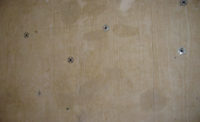After a few years in a home, whether it’s new or old, your clients may notice their walls aren’t as impressive as they once were. If the repairs go beyond surface nicks, dents or scratches, it doesn’t mean you need to outsource the work to get it done. Regardless of the damage—from simple to severe—use the following tips to tackle any wall repairs you encounter on a job.
Water Damage
According to the Insurance Information Institute, 25 percent of all property losses suffered by homeowners result from water leaks. Your clients may detect leakage based on a foul odor, dark wall stains or swelling on the surface. Use a moisture meter on the walls to detect if water is present, and if so, consider these steps to repair the issue.
If a section of drywall is damaged by water, remove all loose layers from the surface using a putty knife and then cut out the damaged area at least two inches past the saturation. Make sure to cut the hole large enough to expose studs. If insulation is in the wall, remove it and allow the area to dry for 24 hours. Next, replace the insulation using new material, and cut a piece of drywall to fit snugly into the hole. Attach with drywall screws and cover with mesh drywall tape to conceal the seams. Now the area’s ready for sanding and painting.
Concrete Cracks
The foundation of newly built homes typically settles within the first three years; as a result, cracks in the concrete foundation of the basement may emerge, while older homes are likely to develop cracks as erosion sets in due to weather changes. No matter how cracks appear, they can be an eyesore for your customers. While not every crack is cause for concern, it’s important to recognize which are significant. Long, horizontal cracks bigger than 1/4-inch can be a sign of serious damage—in this case, a structural engineer should be enlisted to inspect the foundation. Other cracks, such as hairline or vertical, may be repaired permanently with an epoxy-injection system kit:
- Remove any existing debris or loose concrete within the crack by scouring the area with a wire brush.
- Tap 3-inch finishing nails along the crack to align the plastic injection ports included within the kit.
- Mix the epoxy crack sealer on a board and then spread it onto the base of the injection ports, making sure not to plug the hole. Slide the plastic ports onto the nails and press into the wall.
- Smear additional epoxy sealer onto the entire crack with a putty knife; fully cover the injection ports with the sealer, as well.
- Allow the sealer to cure for six hours and then inject the epoxy into the injection ports using a caulk gun until all are filled.
- Plug each injection port and allow the epoxy to then cure for four days.
- Cut off the extending necks of the injection ports with a hacksaw for a flat finish.
Tackling Coarse Wall Surfaces
Following any wall repair, painting is the last step to leave your project looking brand new. To achieve the best painting results, make sure to have the right products to save time and money.
Multi-family buildings, hospitality structures (such as hotels), hospitals, as well as homes in the southwestern and western regions of the U.S., often have textured wall surfaces like orange peel and knockdown. Although these surfaces are the easiest to repair undetectably, they are generally difficult to paint without the use of a paint sprayer. Plus, regular painter’s tape is not very effective in achieving sharp paint lines on these coarse surfaces, and paint bleed often occurs. Many contractors apply caulk to the edges of tape as a way to create a sharp line on uneven surfaces, which can be messy and extremely time consuming. To combat this, FrogTape brand painter’s tape has introduced FrogTape Textured Surface—a first of its kind solution kit to help users achieve a flawless finish with sharp paint lines on textured walls, saving time and money.
This product has a simple application—apply just like traditional painting tape, and rub a damp cloth along the edges to activate the patented PaintBlock Technology, which seals the edges of the tape and keeps paint from seeping through. Lastly, apply the Liquid PaintBlock Edge Sealer and remove the tape after the last coat of paint is dry to the touch. The end result is a sharp paint line on rough or uneven surfaces that took only minutes to achieve, without the need for caulking or touch ups. Not only are your customers satisfied with the results, your team will be able to quickly move on to the next job.
Worn out walls can affect the entire look of a room. Regardless of the severity of the repairs, help maintain the value—and structural integrity—of your client’s home by keeping surfaces in shape.









